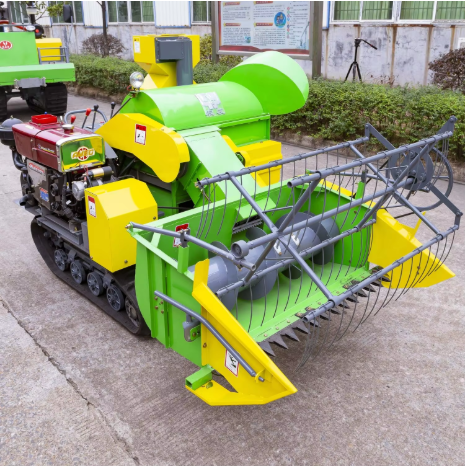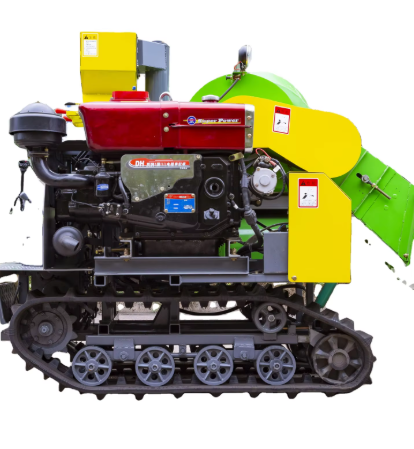Co je přesadovací stroj na rýži? Definice a účel
Od manuální práce ke mechanizované efektivnosti
Po generace se výsadba rýže prováděla zcela ručně, což znamenalo namáhavou práci a dlouhé dny ve vodou nasycených polích. Farmáři trávili týdny ohnutí v blátivých ryžových polích, kde pečlivě vysazovali každé sazenice na příslušné místo. Vše záviselo na dostatku pracovníků ochotných vykonávat práci za náročných podmínek. Všechno se změnilo, když se objevily mechanické výsadbaře. Tyto stroje snížily počet pracovníků potřebných pro tuto práci, umožnily výsadbu provést přesně ve správnou dobu a zároveň ušetřily náklady na mzdy. Některé studie ukazují, že moderní technika může snížit potřebu pracovní síly až o 80 % ve srovnání s tradičními metodami. Nedávný článek v Journal of Modern Agriculture upozorňuje na to, že farmáři, kteří přecházejí na stroje, často pozorují výrazné zlepšení svých výsledků již během jedné nebo dvou sezón.
Hlavní funkce: Přesazování semínek do zaplavených polí
Rýžové výsadbače fungují tak, že přesouvají mladé rostliny do zaplavených rýžových polí místo přímého výsevu semen. Zaplavená pole hrají při pěstování rýže velkou roli, protože potlačují plevel a zajišťují právě správné množství vlhkosti pro křehké sazenice. Stroje zvládnou poměrně dobře umístit každou rostlinu v pravidelných intervalech a do správné hloubky, i když se během sezóny mění počasí. Nedávná zpráva Mezinárodního ústavu pro výzkum rýže ukázala, že farmáři, kteří přešli na tyto výsadbače, zaznamenali zdravější plodiny a lepší úrodu celkem, což vysvětluje, proč se na ně přes počáteční náklady stále více pěstitelů rozhoduje.
Druhy přesadových strojů pro rýži: Designní variace a aplikace
Přesadovače s tlačením pro malé farmy
U malých farem dobře fungují ručně řízené výsadbače, protože jsou snadno ovladatelné a jejich provoz není příliš nákladný. Většina modelů vyžaduje manuální ovládání, díky čemuž mohou farmáři sledovat, co se během výsadby děje. Tento způsob práce hraje velkou roli zejména při práci na obtížném terénu. Malé farmy často mají nepravidelné pozemky nebo oblasti, kam se větší technika vůbec nedostane, a proto jsou tyto kompaktní stroje v mnoha případech zcela nezbytné. Proklouznou úzkými cestičkami mezi řádky a kolem překážek, které by zastavily konvenční techniku.
- Obratnost : Dovedou snadno navigovat úzkými prostory a nerovným terénem, čímž zajistí efektivní transplantaci i v náročných podmínkách.
- UŽIVATELSKY PŘÍTOMNÝ : Jsou navrženy pro jednoduché použití a lze je ovládat osobami s minimálním výcvikem.
- Nákladově efektivní : S nižšími počátečními náklady a sníženými požadavky na údržbu jsou přístupné pro majitele malých farémek.
Doporučení od uživatelů konzistentně chválí tyto transplantéry za jejich účinnost a spolehlivost, což zvyšuje efektivitu v různých malých zemědělských prostředích.
Stroje s vedením ze sedačky pro velké operace
Jízdní přesadovače rýže jsou navrženy pro potřeby velkého měřítka, nabízejí vysoký výkon a efektivitu. Tyto stroje jsou samohybné a schopné přesazovat velké množství setin za hodinu, což významně zvyšuje produktivitu ve srovnání s ručními metodami přesazení.
- Pokročilá technologie : Vybaveny technologií, která umožňuje rychlejší přesazování a vyšší přesnost umístění setin.
- Zvýšená kapacita : Schopny zpracovat velké objemy setin rychle, což je klíčové pro rozsáhlé polní plochy.
- Efektivita : Vysoká rychlost přesazování umožňuje farmerům pokrýt větší plochu v kratším čase.
Několik studií z velkých farm ukazuje významné zvýšení produktivity díky použití jízdních přesadovačů, které se osvědčily jako nezbytná investice pro maximalizaci zemědělské výroby.
Automatické GPS-povolené přesadovače
Automatické transplantéry s GPS technologií představují nejnovější technologii v pěstování rýže, zvyšují přesnost ve farmářském hospodářství díky integraci s GPS systémy. Tato technologie optimalizuje výsadbu a zajišťuje efektivitu a přesnost, minimalizuje překrývání a mezery.
- Přesná výsadba : GPS technologie zajistí jednotnost v módě výsadby, což je klíčové pro optimální zdraví plodin.
- Zlepšení účinnosti : Snižuje lidské chyby a maximalizuje účinnost rozvržení, čímž vede k lepšímu využití pozemků na polích.
- Zvýšení výnosu : Výzkum v agrárním prostředí ukázal zlepšení výnosu souvisejícího s přesností nabízenou systémy s GPS technologií.
Tyto transplantéry představují budoucnost zemědělství, s studiemi ukazujícími významné zvýšení výnosu a konzistence v různých klimatických podmínkách, což demonstруje transformační potenciál technologie v zemědělství.
Příprava semínek v trychtýřích typu matice
Pěstování rýžových sazenic v rohožových pěstebních paletách zásadně ovlivňuje dosažení rovnoměrného vývoje rostlin na poli. Tyto speciální palety pomáhají rovnoměrně rozdělit půdu a živiny po celé paletě, takže každá rostlinka dostane vše, co potřebuje. Rovnoměrný růst znamená zdravější sazenice připravené k přesazení a nakonec lepší úrodu. Sazenice pěstované tímto způsobem obvykle vyvíjejí mnohem silnější kořeny, což zemědělci ihned znají, jakmile je vysadí do rýžových polí. Odborníci na zemědělství zdůrazňují, že správná péče v této fázi se později opravdu vyplatí. Velký význam má pravidelná vlhkost a také přiměřené hnojení vhodnou směsí živin. Správné zvládnutí těchto základních kroků před přesazením do hlavního pole vytváří základ pro úspěšnou pěstovací sezonu za sezonou.

Vyzvedávače a mechanismus na dodávku setek
Sběrací kleště tvoří důležitou součást každého výsadbače rýže, jejichž hlavním účelem je vyjmout jemné sazenice, aniž by je poškodily. Tyto kleště úzce spolupracují s takzvaným podavačem sazenic, přičemž společně zajišťují, že každá rostlina je během přesunu správně manipulována a nezraněna. Při pohybu po poli tyto malé mechanické kleště opatrně uchopí mladé rostliny, zatímco podavač zároveň zajistí správné vyrovnání všech částí před jejich vložením do půdy. Důležitým faktorem je dosáhnout správné vzdálenenosti mezi řádky a přesné výsadbové hloubky, což má velký vliv na zdravý růst rýže v pozdějších fázích. Mnozí zemědělci považují za velmi užitečné diagramy, které jim pomáhají pochopit, jak všechny tyto komponenty vzájemně působí během reálných výsadbových operací za běžných podmínek.
Upravitelné meziřádkové rozestupy a hustota vysázení pro optimální hustotu
Možnost úpravy rozestupu řádků a sklonu svahů zásadním způsobem ovlivňuje dosažení ideální hustoty výsadby v rýžových polích. Zemědělci mají možnost tyto nastavení doladit podle potřeb svých plodin a podle aktuálního stavu prostředí, což jim umožňuje vytvářet plány výsadby, které skutečně fungují pro jejich konkrétní situaci. Vezměme si například oblasti s vysokou vlhkostí vzduchu – mnoho pěstitelů zde volí větší vzdálenosti mezi rostlinami, aby omezili problémy jako plíseň a houbové onemocnění. Pokud se však jedná o suché oblasti, častěji se osvědčuje hustší výsadba, protože lépe využívá dostupný prostor bez plýtvání půdou. Výzkum zemědělských odborníků jasně ukazuje, že změna hustoty výsadby výrazně ovlivňuje výnosy. Proto je tak důležitá existence nastavitelných možností pro zvýšení produktivity a zároveň udržení zdraví rýžových rostlin po celou vegetační sezónu.
Klíčové součásti ricového transplantátu a jejich role
Vodiče a systém pohonu motoru
Poháněcí kola hrají ve výsadbačích rýže opravdu důležitou roli, díky nimž je výrazně usnadněno jejich pohybování a ovládání. Tato kola umožňují stroji přejíždět různé typy terénu bez toho, aby se zasekla, čímž zajišťují hladký průběh výsadby. Systém pohonné jednotky uvnitř těchto strojů úzce souvisí s jejich skutečným výkonem, protože dodává energii potřebnou pro všechny pohyblivé části. Stroje s výkonnějšími motory mají obvykle lepší výkon, zejména na větších farmách, kde rychlost zásadně ovlivňuje rychlé pokrytí rozsáhlých ploch. Při prohlížení různých modelů by měli zemědělci věnovat pozornost specifikacím, jako je výkon v koňských silách, při výběru zařízení. To jim řekne, jaké typy polí je možné efektivně zvládnout v závislosti na velikosti a terénních podmínkách.
Nosné dílce se semeny a přesné vkládací mechanismy
Růstové paňové desky zásadně ovlivňují úspěšné vysazení rostlin do země. Zemědělci na ně spoléhají jako na dočasné domovy pro mladé rostliny, než je vše přesunou do polí či zahradních pozemků. Velký význam má, aby byly tyto malé rostliny zasazovány přesně do správné hloubky a ve správné vzdálennosti, což výrazně ovlivňuje jejich zdravý růst v pozdějších fázích. Některé novější systémy jsou nyní vybaveny speciálními konstrukcemi, které jemně vedou každou sazenici na místo určení, aniž by poškodily jejich křehké kořeny – něčeho, v čem tradiční metody často selhávaly. V poslední době jsme zaznamenali významné vylepšení díky věcem jako senzory a automatické vedení vestavěná do výsadbových strojů. Tato inovace pomáhá zajistit, aby všechny řady na velkých polích vypadaly rovnoměrně, což nakonec vede k lepším sklizním a nižším ztrátám způsobeným slabými nebo poškozenými sazenicemi.
Řízení hloubky pro rovnoměrnou výsadbu
Funkce řízení hloubky u výsadbačů rýže činí obrovský rozdíl, pokud jde o správné nastavení rostlin do půdy do požadované hloubky. Když sazenice dostatečně a rovnoměrně zapadnou do země, ale nejsou příliš hluboko, zaznamenávají farmáři výrazně menší rozdíly v růstu rostlin v různých částech pole. Studie z japonských a indických oblastí ukazují, že rýžové rostliny lépe dozrávají a efektivněji vstřebávají živiny, pokud jsou vysazovány do rovnoměrné hloubky. Farmáři, kteří vyměnili své výsadbače, hlásí zřetelná zlepšení celkového výkonu polí. Samozřejmě existují některá obtížnější místa v okolí zavlažovacích kanálů, kde je situace poněkud složitější, ale obecně platí, že kvalitní řízení hloubky vede k silnějším plodinám a v podzimních měsících k větším úrodám.
Výhody použití transplantéru pro rýži ve moderním zemědělství
snížení práce o 90 % ve srovnání s ručním zaséváním
Výsadba rýže výrazně snižuje potřebu pracovní síly, a to podle výzkumů, které ukazují, že některé farmy ušetří přibližně 90 % nákladů, které dříve vynakládaly na ruční výsadbu. Dopad na rozpočet farmy je obrovský, když po několik dní není zapotřebí zaměstnanců, což znamená nižší výdaje a celkově lepší ziskovost. Vezměme například indické farmy, které se nedávno přesunuly na mechanické výsadbové systémy. Tyto provozy ušetřily velké částky na mzdách a zároveň vypěstovaly více rýže na akr. Farmáři, kteří tuto technologii přijali, se již nemusí tolik starat o dostatek pracovníků během špičkových sezón. Mohou rozprostřít svou omezenou pracovní sílu na jiné klíčové úkoly a nechat rýžová pole bez dozoru.
Vysoká efektivita: Operace 1 hektaru za hodinu
Rýžové výsadbače opravdu zvyšují produktivitu, protože umožňují pěstitelům zvládnout přibližně jeden hektar za hodinu, což je mnohem rychlejší než provádění celé práce ručně. Díky takové rychlosti mohou pěstitelé plánovat výsadbu podle příznivých počasí, místo toho, aby pracovali jen když mají čas. Studie porovnávající různé metody ukazují, že stroje zvládnou práci mnohem rychleji než lidé kopající jamky a vysazující sazenice ručně. Výsledkem jsou lepší úrody, protože plodiny se správně ujistí, a navíc úspory nákladů na jednotku výměry v dlouhodobém horizontu.
Zvýšené výnosy plodin díky konzistentnímu rozestupu
Rýžové výsadbače pomáhají vytvořit přesnou vzdálenost mezi rostlinami, což je velmi důležité, pokud si farmáři přejí, aby jejich pole dosahovala maximálního výnosu. Pokud jsou rostliny rozmístěny rovnoměrně, dostávají od přírody přesně to, co potřebují – vhodné oslunění a vyvážený příjem živin po celé vegetační období. Zemědělští výzkumníci na to upozorňují již mnoho let a díky polním pokusům prokazují, že rovnoměrně vysazené řady obvykle zajišťují lepší sklizeň v různých oblastech. Finanční výhoda se stává zřejmou, když se zvýšené výnosy promítnou do vyšších zisků zejména pro malé pěstovatele. Ačkoliv tyto stroje mají pro moderní zemědělské metody značnou hodnotu, mnoho farmářů stále používá tradiční způsoby výsadby prováděné ručně, a to zejména kvůli pořizovacím nákladům a nárokům na údržbu.
GPS Technologie v Přesadových Strojích: Zlepšování Přesnosti
Mapování Polí pro Optimalizované Sázecí Vzory
GPS technologie mění způsob pěstování rýže po celé zemi. Díky ní mohou farmáři detailně mapovat svá pole, což znamená, že mohou mnohem lépe než dříve plánovat, kde vysázet každou řadu. Když si někdo tyto mapy prohlédne, začne objevovat příležitosti k většímu výnosu rostlin na dostupném prostoru a zároveň udržovat rovnoměrné rozestupy. Skutečně výhodné však je období po výsadbě. Tyto detailní mapy pomáhají také efektivněji spravovat zdroje. Voda se rozvádí tam, kde je nejvíce potřebná, a hnojiva se neplýtvají na oblastech, které je nepotřebují. Většina farmářů, kteří tuto technologii využívají, hlásí větší úrodu z jejich polí. Některé studie to potvrzují a ukazují skutečné nárůsty výroby ve srovnání s tradičními metodami bez GPS navigace.
Běžné shromažďování dat pro zvýšení výnosu
GPS technologie umožňuje sběr dat v reálném čase pro zemědělce, což se v dnešní době stalo poměrně důležitým pro lepší zemědělské postupy a vyšší výnosy. Když zemědělci získávají aktuální informace o termínech výsadby a péče o plodiny, mohou být chytřejší při rozhodování, co je třeba dělat v každé fázi růstu. Tyto informace jim pomáhají sledovat dění na poli a upravovat postupy podle potřeby, takže plodiny rostou za ideálních podmínek a celkově dosahují lepších výsledků. Studie ukazují, že farmy využívající tento datově řízený přístup obvykle dosahují větších sklizní než ty, které spoléhají výhradně na zkušenosti. Pro mnoho pěstitelů znamená přístup k přesným údajům o polích výhodu oproti konkurenci, která se snaží z každého metru půdy vytěžit maximum produktivity a zisku při co nejnižších nákladech.
Budoucnost přesadovačů rýže: trendy a inovace
Integrace umělé inteligence pro adaptivní zemědělství
Zavedení umělé inteligence do výsadbačů rýže otevírá nové vzrušující možnosti pro moderní zemědělské metody. Tyto chytré systémy dokáží sledovat dění v okolí – zjišťují stav počasí, analyzují kvalitu půdy, sledují vývoj porostu po jednotlivých fázích. Na základě toho poté optimalizují proces výsadby, téměř jako by zkušený zemědělec neustále monitoroval každý metr pole. Zemědělci, kteří vyzkoušeli první verze těchto zařízení, hlásí zřetelná zlepšení jak ve výnosu, tak v řízení zdrojů. Většina odborníků souhlasí s tím, že zavádění umělé inteligence do rýžových polí se teprve začíná. Ačkoliv plné nasazení může nějakou dobu trvat, mnoho odborníků věří, že během příštích pěti až deseti let uvidíme výrazný pokrok, protože tyto stroje budou čím dál více učit zkušenostmi a zvládnou více úkolů bez nutnosti lidského zásahu.
Udržitelné návrhy pro ekologické zemědělství
Průmysl výsadby rýže se pomalu posouvá směrem k ekologičtějším návrhům, protože zemědělci více dbají na svůj dopad na životní prostředí. Nové materiály a chytřejší inženýrství snižují emise CO2 i celkové energetické nároky, což přispívá k šetrnějším zemědělským postupům. Začínáme vidět například použití plastů z rostlinných surovin v částech, které by normálně s časem degradovaly, stejně jako menší motory, které čistěji pracují a vyžadují méně časté doplňování paliva. Výzkum z několika univerzit ukazuje na skutečné výhody při přechodu na tyto ekologicky vědomé varianty. Testy prokazují, že farmy využívající udržitelné výsadbače vypouštějí méně škodlivých plynů a dlouhodobě vlastně zlepšují kvalitu půdy. Ačkoli zelená technologie může zpočátku přinést vyšší náklady, mnoho zemědělců zjišťuje, že dlouhodobé úspory a lepší výnosnost plodin tento zájem stojí. Tento posun představuje důležitý krok vpřed pro zemědělství, i když je stále třeba vyvinout úsilí, aby byla tato řešení dostupná pro malé zemědělce po celém světě.
FAQ
Co je to přesávač rýže?
Přesávač rýže je stroj navržený k automatizaci přesazení rýžových semínek do zaplavených polí, usnadňující práci na farmách a zlepšující výsledky úrodnosti.
Jaké jsou výhody používání přesadovacího stroje pro rýži?
Použití přesadovacích strojů pro rýži významně snižuje náročnost práce, zvyšuje efektivitu pokrytím větší plochy v kratším čase a zlepšuje úrodu díky konzistentnímu rozestupu a přesnému sázání.
Jak GPS technologie zvyšuje funkčnost přesadovacích strojů pro rýži?
GPS technologie v přesadovacích strojích umožňuje přesné mapování a vytváření saděních vzorů, optimalizuje správu zdrojů a zlepšuje výsledky úrody prostřednictvím efektivních poživatelských praktik.
Jaké budoucí technologie mohou ovlivnit přesadovací stroje pro rýži?
Budoucnost přesadovacích strojů pro rýži může zahrnovat integraci umělé inteligence a inovací udržitelného návrhu, což zvyšuje pružnost a ekologickost v zemědělství.
Obsah
- Co je přesadovací stroj na rýži? Definice a účel
- Druhy přesadových strojů pro rýži: Designní variace a aplikace
- Příprava semínek v trychtýřích typu matice
- Vyzvedávače a mechanismus na dodávku setek
- Upravitelné meziřádkové rozestupy a hustota vysázení pro optimální hustotu
- Klíčové součásti ricového transplantátu a jejich role
- Výhody použití transplantéru pro rýži ve moderním zemědělství
- GPS Technologie v Přesadových Strojích: Zlepšování Přesnosti
- Budoucnost přesadovačů rýže: trendy a inovace
- FAQ

